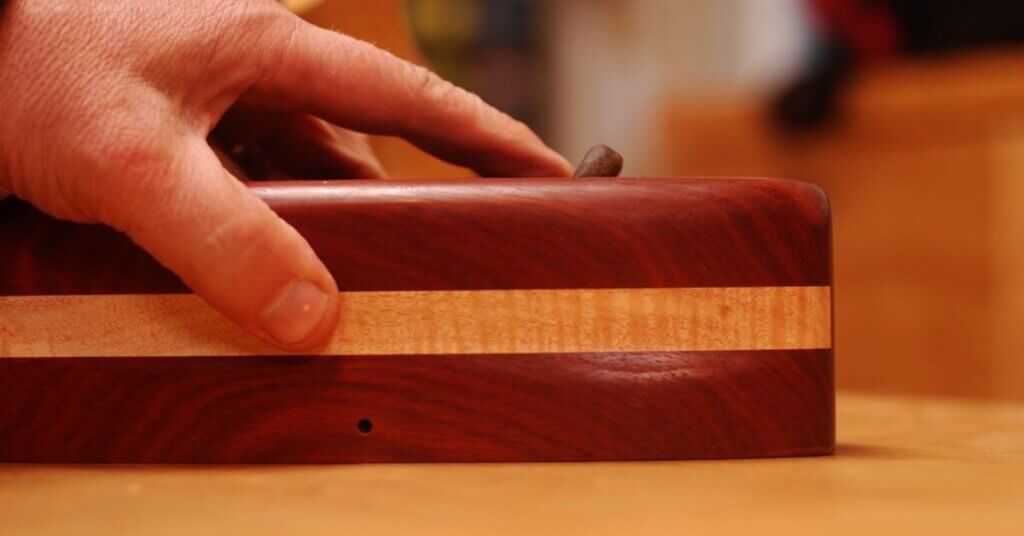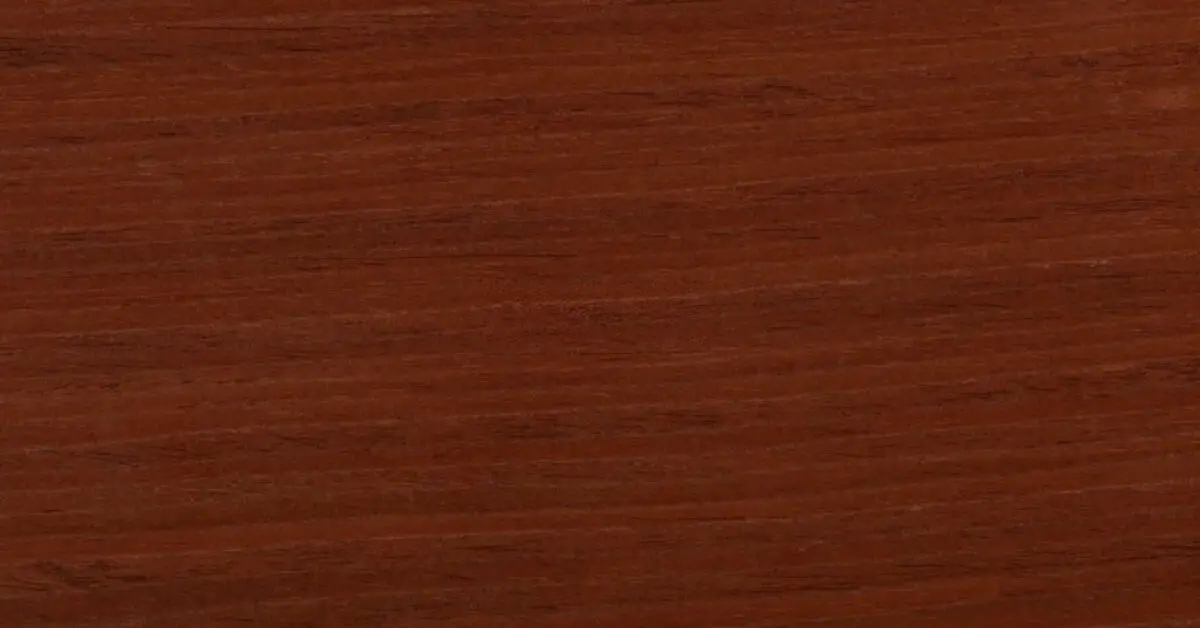Bloodwood, scientifically known as Brosimum rubescens, has attracted people’s attention for its unique deep, bright, vivid red color and extreme hardness. The Bloodwood gets its name from its rich, deep red to reddish-brown color.
Bloodwood trees are native to tropical South America and can reach impressive heights, often topping 80-150 feet. It comes from a deciduous tree ( sheds its leaves each autumn).
Bloodwood is one of the most popular domestic woods for woodworking. Wood is considered a premium exotic hardwood, widely used for furniture, flooring, and carving. Bluewood can be used for outdoor and indoor purpose.
| Scientific name | Brosimum rubescens |
| Tree Size | 20 – 40 m tall with trunk diameter of up to 5 0 -70 cm |
| Janka Hardness | 2,900 lbf (12,900 N) |
| Weight | Elastic Modulus: 3,013,000 lbf |
| Elastic Modulus | 3,013,000 lbf/in2 (20.78 GPa) |
| Crushing Strength | 14,310 lbf/in2 (98.7 MPa) |
| Shrinkage: Radial | 4.6%, Tangential: 7.0%, Volumetric: 11.7%, T/R Ratio: 1.5 |
Characteristics of Bloodwood

Color and Appearance:
Most people are familiar with the color of Bloodwood. It is known for its unique and attractive vivid red color.
Bloodwood’s heartwood (the inner, older part of the tree) is usually a vibrant, blood-red color. The sapwood (the outer, younger part of the tree) is usually lighter in color than the heartwood, ranging from pale pink to yellow or cream. Heartwood and sapwood can be easily distinguished.
Does Bloodwood also change color?
Like most wood, Bloodwood also darkens over time when exposed to light. The process of natural color change of wood is called oxidation.
Bloodwood generally has a straight to slightly interlocked grain pattern. The grain is fine and uniform, giving the wood a smooth texture. The wood has a natural luster that can be further enhanced with a finish.
Rot Resistant:
When we choose wood for projects involving outdoor or soil contact, our biggest question is: Is the wood resistant to rot or insects? Or How long will wood last in outdoor conditions?
So Bloodwood can be a good choice for such a project because it is known for its durability and natural resistance to rot and insects. It is an extremely dense and hard hardwood, which makes it highly resistant to wear and damage.
Water Resistant:
As mentioned above, Bloodwood has a very high density and closed pores, absorbing very low amounts of moisture. Which makes the wood dimensionally stable and highly resistant to warping and shrinkage.
However, experienced woodworkers recommend that if you use Bloodwood for outdoor furniture, you should prepare the wood for outdoor weather. You should seal the wood properly so that the beauty of the wood remains for a long time.
What is Bloodwood Wood Used for?
Bloodwood Flooring
The two main reasons to choose bloodwood wood as flooring are rich aesthetics and durability. Its deep, natural reddish-brown color adds warmth and character to any space. It is extremely durable and highly resistant to scratches, dents and damage, making it ideal for high-traffic areas.
Bloodwood Furniture
Bloodwood is an excellent choice for making high-quality furniture. The durability of Bloodwood ensures that furniture made from Bloodwood lasts a long time, even with regular use, and requires less care than many other hardwoods.
Bloodwood For Knife and Tool Handle
For the handle, Bloodwood is the right choice; is very durable and can withstand high shocks. Bloodwood’s fine texture provides a comfortable grip, allowing for precise handling of knives and tools.
Bloodwood for Carvings and Trim
Bloodwood generally has a fine and uniform grain pattern, providing a smooth surface for carving intricate designs. Its natural deep red color is visually striking and adds a touch of richness to any carving or trim.
The Pros and Cons of Bloodwood
Pros
- Appearance: Of all the qualities of Bloodwood, I am most attracted to its deep red color. Its vibrant color makes it suitable for decorative items and adds a touch of beauty to any woodworking project.
- Durable and Stable: Bloodwood is rated for durability and stability. Its density and hardness make it highly resistant to wear and tear, ensuring longevity in a variety of applications.
- Rot and moisture resistant: Another major advantage of Bloodwood is that it is naturally resistant to rot and moisture. So we can use it for indoor furniture even without any treatment.
- Versatility: Bloodwood is a versatile wood that can be used for everything from home furniture to decorative objects or flooring to tool handles.
Cons
- Hard to Work with Bloodwood is extremely dense and heavy, making it difficult to work with such wood.
- Color doesn’t last: The most disappointing thing about Bloodwood is the oxidation. Bloodwood loses its beautiful natural color and darkens over time.
- High Cost: The exotic nature and limited availability of Bloodwood is the main reason for its expensive nature. For budget-conscious projects, you should consider one of the finest alternative woods of Bloodwood.
Is Bloodwood Easy to Work With?
Bloodwood is not easy to work with, especially with hand tools, due to its extreme density and hardness. But high density is also an advantage that provides durability.
Its density blunts the cutter blade very quickly and sometimes makes a burning effect on the wood surface. Experts believe that bloodwood wood is not a good choice for beginners to start woodworking as this wood can easily break while working.
What Precautions Should Be Taken While Working With Bloodwood?
When working with very hard and dense woods like Bloodwood, it is essential to take certain precautions to ensure your safety and the quality of your work. Here are some important points to follow:
- Wear proper safety gear
- Using Sharp Blades and Bits
- Working slow and steady
- Avoiding splinters and tear-outs
What is the Hardness of Bloodwood?
Bloodwood has a Janka hardness of 2,900 lbf (12,900 N), a hardness value much higher than that of many hardwoods. For example, bloodwood is about twice as hard as maple wood (hardness value is 1,450 lbf (6,450 N)) and three times that of walnut wood (1,010 lbf (4,490 N)).
Here is the Janka hardness of some popular hardwoods to give you a better idea of how hard bloodwood is.
| Wood Species | Janka Hardness |
| Shagbark Hickory | 1,880 lbf (8,360 N) |
| Bubinga | 2,410 lbf (10,720 N) |
| Brazilian rosewood | 2,790 lbf (12,410 N) |
| Bloodwood | 2,900 lbf (12,900 N) |
| Gaboon Ebony | 3,080 lbf (13,700 N) |
| Ipe | 3,510 lbf (15,620 N) |
| African blackwood | 3,670 lbf (16,320 N) |
Is Bloodwood Toxic?
No major problems have been noticed while working with Bloodwood. Wood dust can affect woodworkers, such as thirst and salivation. Common problems like skin and eye irritation may also occur. Once finished, it is completely safe.
But any wood dust can be irritating for asthma patients, so be careful while working on wood.
Frequently Asked Questions
Q1: Is Bloodwood Suitable for Outdoor Projects?
Yes, Bloodwood’s natural resistance to decay and insects makes it an excellent choice for outdoor applications like decking and outdoor furniture.
Q2: Can Bloodwood Be Stained or Painted?
The natural color of Bloodwood is so vibrant that staining is often unnecessary. That’s why many people don’t want to stain it. However, it can be stained or painted if desired, although many woodworkers prefer to showcase its natural beauty.
Q2: What is the Alternative to Bloodwood?
Red heartwood is close in appearance to Bloodwood. The color of red heartwood is bright pink, pinkish-red or red. Although the hardness of Red heart wood is less than that of Bloodwood.
Padauk wood can be another alternative to Bloodwood. Padauk wood (Pterocarpus genus) is known for its vibrant red-orange to deep red color. The color darkens with ageing and exposure to light. Padauk is a hard and dense wood; although it may not be as hard as Bloodwood, it still offers good durability and resistance to wear.

